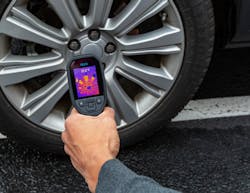Technicians rely on accurate diagnostic tools that enable them to quickly troubleshoot vehicle problems and find the most efficient repair. As vehicles become increasingly complex, technicians need to utilize a wider variety of diagnostic test equipment to keep their diagnostic time as efficient as possible. One tool category that assists with this is thermal imaging tools.
Thermal imaging tools utilize sophisticated sensors to detect differences in temperatures on surfaces of various components and compose a picture of those temperature variations. This makes it easier to pinpoint abnormal temperatures on a component that is not working efficiently, or that is facing imminent failure. These tools also allow technicians to take pictures of a problem to show customers a vivid color portrayal of a problem that needs repairing, helping to lend credibility to the shop’s repair quote.
“For many years, thermal imagers were priced out of the budgets of many automotive shops,” says Richard Wexler, Director – Instruments, FLIR. “Now, with more affordable models increasingly available, the rapid diagnostic power of thermal imaging is within reach of many dealer and standalone automotive repair facilities.”
And, as thermal imaging tools continue to become more cost-effective for automotive repair shops, this provides a sales opportunity for distributors who understand the diagnostic value this tool category has to offer.
Uses of thermal imaging tools
Thermal imaging tools can be used to diagnose a wide variety of issues. Wexler offers the following examples of applications where a thermal imaging tool can streamline diagnosis:
- An electrical component is not working properly. A wiring connection or fuse might be corroded, causing increased resistance and overheating. An issue like this might be concealed by electrical tape, connectors, or wireloom, but a thermal imager could pinpoint the issue. Similarly, a thermal imager can be used to diagnose other electrical components such as coil packs.
- An accessory belt is failing repeatedly. A thermal imager can reveal if a misalignment of pulleys is causing overheating and putting stress on the belt. It can also test whether the air conditioning system is working properly. Surface temperatures of high- and low-pressure lines can be checked for damaged insulation Failing thermostats, clogged or blocked radiators or coolant lines will be apparent when only part of a radiator shows it’s working properly, or a line has a sudden change in temperature after one spot along the hose where a blockage is likely located.
- Drivetrain and suspension diagnostics A thermal imager can reveal excessive friction from worn components.
- Brakes with stuck pistons. Stuck pistons might be causing one caliper to stick, causing abnormal wear and heat on one rotor—the same might also be true for a stuck parking brake with damaged cable.
- Exhaust system leaks, cracked manifolds, failed gaskets and clogged catalytic converters. A thermal imager can be used to pinpoint and document these issues.
- Failures in components like heated and cooled seating surfaces.
- Damaged rear window defroster gridlines.
- Dashboard switchgear for components with high current draw. Items such as accessory driving lights, heated seats or drive modes might be carrying abnormal resistance or shorting, and they will heat up, indicating a failing switch or relay.
- Failing injectors, misfiring or low pressure in one cylinder. These items can be revealed by a stark contrast of the suspect cylinder’s manifold showing a lower temperature than others.
If a distributor can help shop owners understand the value a thermal imaging tool can bring to their diagnostic process, and demonstrate that this tool category is becoming more affordable, they can make a strong case for the sale.
Finding the right fit for the job
As with any diagnostic tool, the best solution depends on the application. There are a variety of criteria for helping shops decide on the proper thermal imaging tool for them.
There are two main types of thermal imaging tools available: a dedicated thermal imager designed for automotive use, or an electrical test meter with a built-in thermal imager. A dedicated thermal imager tends to be easier to aim and has a larger display, but for shops looking for a more economic option, a hybrid thermal imaging electrical meter can offer many of the same capabilities.
All thermal imaging tools essentially work the same way, says Javier Hernandez, project manager, JS Products.
“Where [thermal imaging tools] differentiate themselves is in the temperature range and thermal resolution. Both temperature and resolution will affect the cost of the unit,” he explains.
The better the resolution, the more detail technicians will be able to see. And, higher resolution tools will offer a better range, allowing users to see longer distances using the tool. Temperature sensitivity is also an important aspect of thermal imaging tools, especially for automotive applications. Choosing tools with a larger temperature range will allow the widest possible range of diagnostic capabilities.
Another factor to consider is the “distance to spot” ratio, FLIR’s Wexler says. In other words, how close do you need to be to get an accurate reading? “Farther is always better,” he adds. “For example, an imager with a 1:12 ratio works best one foot away, while a 1:30 ratio provides an added layer of safety and accuracy at 30” away.”
Also consider the durability of the tool, whether it has any convenient extras such as a built-in light and laser pointer, and image storage.
Tips for selling
Shops want to buy equipment that provides demonstrated value. If they can see how a product will save them time and effort, they will be more likely to purchase it. This is especially important for thermal imaging tools, since many shops believe that these tools are cost-prohibitive and out of budget.
“Give them examples of common problems and show how the thermal imager can help resolve those issues faster,” suggests JS Products’ Hernandez.
“Thermal imagers are a high impact and hands-on tool,” Wexler adds. “Use a security cable if needed, but make sure customers can handle the imager and try it out. Seeing is really believing, and that’s what will get customers excited. The best way to demo it is to let them try it on a car they’re working on, or to scan your truck’s components to see what it reveals.”
As a conversation starting point, ask the shop if they ever have a hard time convincing customers to agree to repairs. If they say yes, ask if the ability to show a customer a vivid picture of what’s wrong with their vehicle might help build trust and get them to agree to complex repairs that can be hard to explain.
Ask questions about the specific applications that they will be using the thermal imaging tool for, what features they would like to have, and then suggest a tool that best fits those needs. For example, if the shop intends to use the thermal imager for a lot of diesel engines or turbocharged engines, they will need a thermal imaging tool with a larger temperature range, so the tool can handle the temperatures these super-hot components can reach. More tech savvy shops might appreciate a tool that has the ability to “talk” to the shop’s iPad using Bluetooth to show customers what the technician is working on.
Like with a phone or digital camera, image storage is an important consideration. Thermal imaging tools should have enough storage for larger, high resolution images. As a general rule, 4GB is a good standard, Wexler suggests. Many thermal imagers have expandable memory, so consider stocking extra memory cards, as well as extra batteries and protective storage cases, to encourage add-on sales.
Take the time to understand the tools you are trying to sell as thoroughly as possible, and take advantage of resources provided by the company, such as videos that help highlight the top features of each tool. “In order to have success in selling thermal imaging products, it is crucial that distributors educate themselves on how to use and demonstrate [these tools],” Hernandez says.
This is a difficult product category to sell without a demonstration if the shop doesn’t already use thermal imaging tools. Distributors that are able to show how this tool category can streamline vehicle diagnostics will have a competitive edge when selling to shops.
“Many prospective customers have preconceived notions that thermal imagers are cost-prohibitive and out of budget,” Wexler says. “Don’t end the conversation there. Prices have come down dramatically, even over the last few years. Make sure they know that!”
Thermal imaging tools are not a specialty tool—they are a tool that can be used for a variety of diagnostic applications. Boost sales by helping prospective buyers understand how this powerful tool category could change their day-to-day diagnostic process to make it more efficient.
About the Author
Stefanie Von Rueden
Assistant Editor - Vehicle Repair Group
Stefanie Von Rueden is assistant editor for the Vehicle Repair Group.
Von Rueden’s background includes professional writing and publishing. Previously, she worked in the Continuing Education department at UW-Whitewater. She has covered the vehicle maintenance and automotive aftermarket since 2016.

